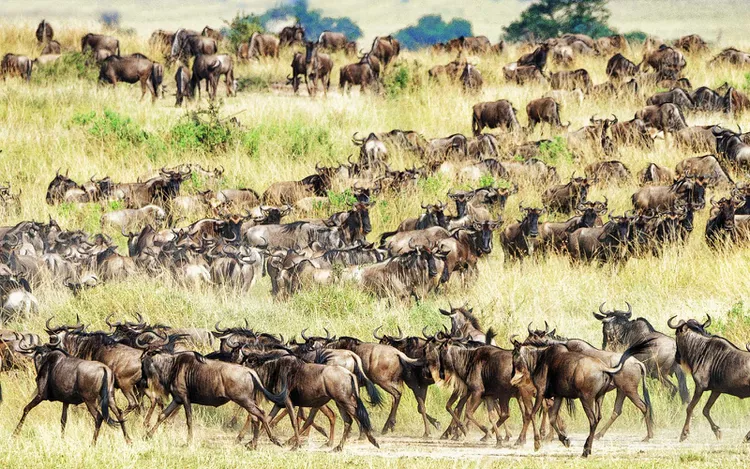Summary of the Great Migration
The Wonder of the Migration
Often hailed as one of the wonders of the natural world, Africa’s great wildebeest migration is an incredible event to witness. Every year, between 1.5 and two million or more wildebeest — along with gazelles and zebra — stampede Lion King-style across the veldt of southern Africa. When dry, cool August descends upon the Serengeti in Tanzania, the wildebeest begin their astounding journey north, following the rains to the Masai Mara in Kenya. In a single year, these massive herds can migrate nearly 1,000 miles during one of the largest mammal migrations on Earth.
If witnessing this incredible journey is on your bucket list, here’s everything you need to know about seeing the “great migration.”
Following the Migration Path
Rather than a singular occurrence, it helps to think of the great migration as an ongoing, circuitous event that is governed by the seasons and the availability of food. From December until May, the wildebeest are largely concentrated in the southern Serengeti. Here, they birth their young before slowly working their way northwest across the grassy plains. In April and May, the herds will follow the Grumeti River that snakes its way across Serengeti National Park.
By June, when the rainy season starts to wind down and the prairie grasses are exhausted, the herds will continue their migration to Kenya’s Masai Mara. Mid-July through mid-September is the best time to see the great migration — and your chances of witnessing a river crossing are generally much higher. Come early October, the rainy season in Tanzania will commence, and the herds will embark on their return journey back to the Serengeti.
However, because the herds are always on the move, it’s possible to see the wildebeest any time of year — as long as you’re strategic about your location. Travel agent Lisa Lindblad recommends positioning yourself in the Masai Mara as early as July.
How to See the Herds
Guarantee you’ll see the great wildebeest migration by hiring a professional guide or safari operator. Experts in the area can ensure you have the perfect vantage point to watch the animals thundering across the plains.
Natural Habitat Adventures is best known for its focus on conservation and as the first carbon-neutral travel company. It is also a partner of the World Wildlife Fund, the world’s leading conservation organization. Safari itineraries focus on small groups and lodges in less-traveled settings.
Moreover, for something more luxurious, consider Abercrombie & Kent. This company arranges high-end trips with tented camps and elegant safari lodges. Travelers can also go all-out with a 15-day Grand Safari by Micato. This two-week adventure includes a hot-air balloon tour and stays at properties like the Four Seasons Safari Lodge Serengeti or the andBeyond Bateleur Camp (complete with private butlers and commanding views of the Mara plains).
Consequently, in addition to seeing the migration, a trip to Africa for a safari will give travelers the opportunity to meet local Masai naturalists or members of the Hadza tribe. Be sure to engage with your guide about not just wildlife but also the varied cultures of southern Africa.
If you can’t make your way to Africa to see the wildebeest migration in person, there’s another option: The web app HerdTracker makes it possible to follow the live migration virtually.




